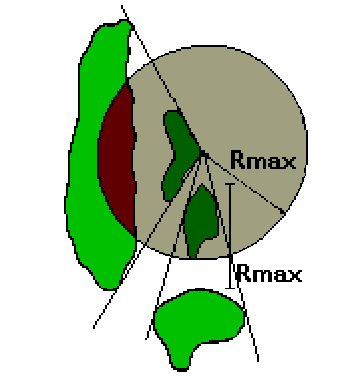Dr. Brad Muller
Range folding takes place when a radar echo from outside the radar's maximum unambiguous range gets displayed incorrectly within the radar range:

The maximum unambiguous range is determined by the PRF (pulse repetition frequency).
The time between pulses is given by T = 1/PRF.
Therefore the maximum range that a signal can travel out and back before the next pulse is emitted is
Rmax
= c T/2
where c is the speed of electromagnetic radiation. Substituting for the time gives the maximum unambiguous range in terms of the PRF:
where c is the speed of electromagnetic radiation. Substituting for the time gives the maximum unambiguous range in terms of the PRF:

The radar assumes that any returned echo is from the most recent electromagnetic radiation pulse that it has sent out. If it receives a distant echo from the pulse previous to the most recent, it thinks the return is from the latest pulse and accordingly plots it closer than where it really is; this is called a "second trip echo." The signal indicated at range R, actually originates at a distance of R+Rmax . If the radar displays an echo from the pulse before the previous pulse, it is called a "third-trip echo" and the actual distance is R+2Rmax and so on.
The following three figures show how a range-folded or second-trip echo comes about (Figures below from the Warning Decision Training Branch of the National Weather Service):



Normally, we think of reflectivity as subject to range folding, but doppler velocities can be range folded as well. Normally range folded velocities are displayed as purple. Because high PRF's are necessary for getting good velocity data, the maximum unambiguous range to collect the velocity data is lower than for reflectivity that is collected using lower PRF's. The image below shows range folded velocity data outside the maximum unambiguous range.
